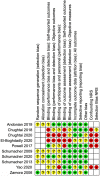Use of powered air-purifying respirator (PAPR) by healthcare workers for preventing highly infectious viral diseases-a systematic review of evidence
- PMID: 32771035
- PMCID: PMC7414632
- DOI: 10.1186/s13643-020-01431-5
Use of powered air-purifying respirator (PAPR) by healthcare workers for preventing highly infectious viral diseases-a systematic review of evidence
Abstract
Background: Healthcare workers (HCWs) are at particular risk during pandemics and epidemics of highly virulent diseases with significant morbidity and case fatality rate. These diseases include severe acute respiratory syndrome coronaviruses, SARS-CoV-1 and SARS-CoV-2, Middle Eastern Respiratory Syndrome (MERS), and Ebola. With the current (SARS-CoV-2) global pandemic, it is critical to delineate appropriate contextual respiratory protection for HCWs. The aim of this systematic review was to evaluate the effect of powered air-purifying respirators (PAPRs) as part of respiratory protection versus another device (egN95/FFP2) on HCW infection rates and contamination.
Methods: Our primary outcomes included HCW infection rates with SARS-CoV-2, SARS-CoV-1, Ebola, or MERS when utilizing PAPR. We included randomized controlled trials, non-randomized controlled trials, and observational studies. We searched the following databases: MEDLINE, EMBASE, and Cochrane Library (Cochrane Database of Systematic Reviews and CENTRAL). Two reviewers independently screened all citations, full-text articles, and abstracted data. Due to clinical and methodological heterogeneity, we did not conduct a meta-analysis. Where applicable, we constructed evidence profile (EP) tables for each individual outcome. Confidence in cumulative evidence for each outcome was classified according to the GRADE system.
Results: We identified 689 studies during literature searches. We included 10 full-text studies. A narrative synthesis was provided. Two on-field studies reported no difference in the rates of healthcare workers performing airway procedures during the care of critical patients with SARS-CoV-2. A single simulation trial reported a lower level of cross-contamination of participants using PAPR compared to alternative respiratory protection. There is moderate quality evidence that PAPR use is associated with greater heat tolerance but lower scores for mobility and communication ability. We identified a trend towards greater self-reported wearer comfort with PAPR technology in low-quality observational simulation studies.
Conclusion: Field observational studies do not indicate a difference in healthcare worker infection utilizing PAPR devices versus other compliant respiratory equipment. Greater heat tolerance accompanied by lower scores of mobility and audibility in PAPR was identified. Further pragmatic studies are needed in order to delineate actual effectiveness and provider satisfaction with PAPR technology.
Systematic review registration: The protocol for this review was prospectively registered with the International Register of Systematic Reviews identification number CRD42020184724 .
Keywords: Healthcare worker; Powered air-purifying respirator; Respiratory protection; SARS-CoV-1; SARS-CoV-2.
Conflict of interest statement
No external funding and no competing interests declared.
Figures
Similar articles
-
Personal protective equipment for preventing highly infectious diseases due to exposure to contaminated body fluids in healthcare staff.Cochrane Database Syst Rev. 2020 May 15;5(5):CD011621. doi: 10.1002/14651858.CD011621.pub5. Cochrane Database Syst Rev. 2020. PMID: 32412096 Free PMC article.
-
Personal protective equipment for preventing highly infectious diseases due to exposure to contaminated body fluids in healthcare staff.Cochrane Database Syst Rev. 2020 Apr 15;4(4):CD011621. doi: 10.1002/14651858.CD011621.pub4. Cochrane Database Syst Rev. 2020. Update in: Cochrane Database Syst Rev. 2020 May 15;5:CD011621. doi: 10.1002/14651858.CD011621.pub5. PMID: 32293717 Free PMC article. Updated.
-
Use of powered air-purifying respirator(PAPR) as part of protective equipment against SARS-CoV-2-a narrative review and critical appraisal of evidence.Am J Infect Control. 2021 Apr;49(4):492-499. doi: 10.1016/j.ajic.2020.11.009. Epub 2020 Nov 10. Am J Infect Control. 2021. PMID: 33186678 Free PMC article. Review.
-
Powered Air Purifying Respirator (PAPR) restores the N95 face mask induced cerebral hemodynamic alterations among Healthcare Workers during COVID-19 Outbreak.J Neurol Sci. 2020 Oct 15;417:117078. doi: 10.1016/j.jns.2020.117078. Epub 2020 Aug 3. J Neurol Sci. 2020. PMID: 32768718 Free PMC article.
-
The need of health policy perspective to protect Healthcare Workers during COVID-19 pandemic. A GRADE rapid review on the N95 respirators effectiveness.PLoS One. 2020 Jun 3;15(6):e0234025. doi: 10.1371/journal.pone.0234025. eCollection 2020. PLoS One. 2020. PMID: 32492045 Free PMC article.
Cited by
-
Current Resources for Evidence-Based Practice, November 2020.J Obstet Gynecol Neonatal Nurs. 2020 Nov;49(6):605-619. doi: 10.1016/j.jogn.2020.10.001. Epub 2020 Oct 21. J Obstet Gynecol Neonatal Nurs. 2020. PMID: 33096044 Free PMC article.
-
Novel 3D printable powered air purifying respirator for emergency use during PPE shortage of the COVID-19 pandemic: a study protocol and device safety analysis.BMJ Open. 2021 Aug 26;11(8):e049605. doi: 10.1136/bmjopen-2021-049605. BMJ Open. 2021. PMID: 34446492 Free PMC article.
-
Microbial contamination of powered air purifying respirators (PAPR) used by healthcare staff during the COVID-19 pandemic: an in situ microbiological study.Am J Infect Control. 2021 Jun;49(6):707-712. doi: 10.1016/j.ajic.2021.02.006. Epub 2021 Feb 13. Am J Infect Control. 2021. PMID: 33587982 Free PMC article.
-
[The first year of the SARS-CoV-2 pandemic-impact on otorhinolaryngology].HNO. 2021 Aug;69(8):615-622. doi: 10.1007/s00106-021-01015-2. Epub 2021 Feb 23. HNO. 2021. PMID: 33620505 Free PMC article. Review. German.
-
How Are You Feeling? Interpretation of Emotions through Facial Expressions of People Wearing Different Personal Protective Equipment: An Observational Study.Nurs Rep. 2022 Oct 17;12(4):758-774. doi: 10.3390/nursrep12040075. Nurs Rep. 2022. PMID: 36278768 Free PMC article.
References
-
- Ebola Health: WHO; 2020 [Available from: https://www.who.int/features/ebola/health-care-worker/en/.
-
- Cook TM. Personal protective equipment during the coronavirus disease (COVID) 2019 pandemic – a narrative review. Anaesthesia. 2020;n/a(n/a). - PubMed
-
- Coronavirus disease 2019- Situation report: Worl Health Organization; [Available from: https://www.who.int/docs/default-source/coronaviruse/situation-reports/2....
Publication types
MeSH terms
LinkOut - more resources
Full Text Sources
Miscellaneous




